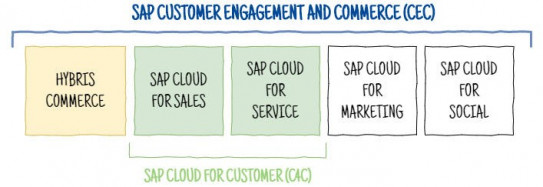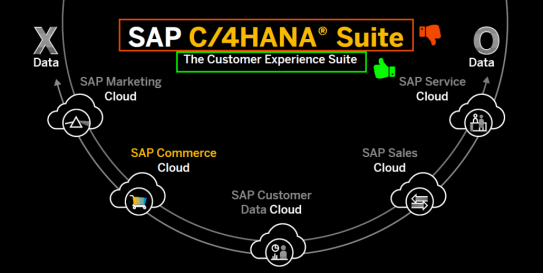
SAP Commerce Cloud demystified
Whether you're new to SAP Commerce, or got confused along the way about the evolving SAP ecommerce offering and versioning, this article will help you put things in the right perspective.
My goal is to help you see clear in terms of the different products, names, options and versions that are floating around in the SAP customer experience universe. At the same time, you should also get a better understanding of how SAP Commerce fits within the broader SAP product portfolio. The easiest way to clarify the current state of affairs is to understand how we got here. Sounds good? Let's get to it.
First there was Hybris
It all started in 2013, when SAP decided to add an ecommerce solution to its portfolio by taking over a high-end Swiss-German ecommerce software builder, called Hybris. At this point the name 'Hybris' simply refered to the newly acquired ecommerce platform - with Hybris v5 being the most current release at that time.
Then there was Customer Engagement and Commerce
It helps to consider the Hybris acquisition within the broader context of SAP's Customer Relationship Management (CRM) strategy. SAP needed a response to two major challenges within the broader CRM market:
- The ongoing transition towards an independent, cloud-based CRM platform - mainly driven by the need to remain competitive and take on SalesForce.com that was providing its software platform as a service, hosted in the cloud, meaning customers didn’t have to worry about upgrades, versions and infrastructure.
- The market shift towards an 'omni-channel' business strategy, which implied that customer relations should no longer be managed separately for each channel but instead required a collaboration and integration of processes across the sales, service and marketing departments.
This also helps to explain why, in 2014, SAP decided to re-shuffle its broader CRM portfolio with a clear objective: consolidate the different sales, service and marketing applications that companies use when interacting (engaging) with customers, and combine those with the new omni-channel Hybris commerce solution. And voila, a new 'platform' was born and labeled "SAP Customer Engagement and Commerce" (CEC).

SAP Customer Engagement and Commerce (CEC) the birth of a platform.
And this is when it gets confusing for a lot of people that are not following up close. You should understand that the different elements within this new CEC platform are not new and existed prior to the Hybris acquisition, and what's more the "Cloud for Sales" and "Cloud for Service" applications had been initially released 3 years prior, in 2011, under the name "Cloud for Customer", conveniently abbreviated to C4C (a successor to the "Customer OnDemand" solution). But instead of dropping the old name "C4C" and replacing it with the new name "CEC", were both left to live in parallel. And to add to the confusion, SAP later on decided to also apply the strong and well-known Hybris brand name to each individual solution within the CEC platform. So within CEC we now have:
- SAP Hybris Commerce
- SAP Hybris Cloud for Marketing
- SAP Hybris Cloud for Customer (C4C) - which consists of "SAP Cloud for Sales" (sometimes also referred to as C4C) and "SAP Cloud for Service" (sometimes also referred to as C4S)
Did you notice that the ecommerce application is still referred to as SAP Hybris Commerce and not 'Cloud for Commerce'? That's simply because the commerce application is still not cloud based. At this point the so-called 'on-premise' model still prevails, obliging customers to come up with their own, proper hardware and infrastructure (either in-house or at a dedicated hosting partner) to install and run the Hybris software. And by the way, some customers are still running their commerce application on-premise.
And finally there is SAP Customer Experience aka C/4HANA
Are you still following? Good, because things changed again in 2018 and unfortunately, SAP succeeded yet again in creating confusion. As a result of adding the newly acquired Gigya (2017), CallidusCloud (2018) and CoreSystems (2018) solutions to the CRM mix, SAP decided that it was time for yet another rebranding. As from this period the SAP CRM universe was referred to as "SAP Customer Experience" (or SAP CX). However, instead of keeping it simple, SAP also introduced a second, distinctly different name for its suite of CRM applications: "SAP C/4HANA".
That acronym C/4HANA is obviously derived from SAP's new ERP suite, which is called "SAP S/4HANA" (where HANA refers to the in-memory database technology that was developed by SAP and now underpins all of its business applications). And since SAP considers "Customer Experience" to be its front-end suite for SAP S/4HANA, it obviously thought C/4HANA to be a catchy word play. But just to be clear, SAP Commerce does not require SAP S/4HANA and can be integrated with any ERP back end system and additionally can be deployed standalone without an ERP back end. Personally, I am still not convinced about the need for two distinct names (CX and C/4) for essentially the same offering. So I'll refer to the explanation provided by SAP, "SAP Customer Experience refers to the broader business capability, while SAP C/4HANA is the underlying product portfolio.", as illustrated below:

SAP Customer Experience suite also known as C/4HANA
Bye Bye Hybris
As you can see in the illustration, SAP also decided to completely abandon the Hybris brand name for all its products at this point. As a result, the commerce application - meanwhile also available as a cloud solution - is now simply referred to as SAP Commerce Cloud … bye bye Hybris. But although the Hybris brand is banned from all official SAP communication, it has still not fully disappeared and until this day, I still see a lot of people using the name Hybris to refer to SAP Commerce. At the same time SAP also started to adopt the corporate naming convention for its release versions, which is why the successor of Hybris v6.7 is not called v6.8 but is instead named "v1808" (where '18' refers to 2018 and '08' refers to August).

SAP Commerce (former Hybris) release history.
SAP Commerce Cloud
That brings us to the conclusion, the current state of affairs. Anno 2020, SAP Commerce Cloud is part of what is now known as the Customer Experience suite. And we received good news in June 2020; SAP (finally) acknowledged the confusion caused by the dual naming and decided to abandon the C/4HANA name, leaving Customer Experience as the only official reference to its software suite – although I expect to still see the C/4 acronym, popping up from time to time. [caption id="attachment_10404" align="aligncenter" width="1030"]

The SAP Customer Experience Suite – since June 2020, the C/4HANA name is officially abandoned
SAP Customer Experience Suite now includes:
- SAP Commerce Cloud (former Hybris) - with v2005 as the latest and most current release
- SAP Marketing Cloud
- SAP Customer Data Cloud (the acquired Gigya solution)
- SAP Sales Cloud
- SAP Service Cloud
SAP Commerce Cloud is positioned as one of the five distinct, yet integrated cloud solutions, and what's more it is no longer available as on-premise solution for new customers. SAP is now also encouraging its existing on-premise customer base to migrate to the cloud version. So, do you have to use all five cloud solutions? No. They can be deployed standalone or in any combination. So that's it? Well not quite…
2 different Commerce Cloud versions
Confusion is lurking around the corner yet again, because there are two versions of the SAP Commerce Cloud offering. This time, the difference is not functional (and thus not linked to the versioning), but rather relates to the hosting infrastructure. When SAP first released SAP Commerce as a cloud solution, it was a private cloud implementation running on a proprietary SAP infrastructure and managed by the SAP HANA Cloud Services (HCS) team. This first version of SAP Commerce Cloud is now referred to as CCv1.
However, soon after this SAP decided to move Commerce Cloud to a public cloud offering on Microsoft Azure, making it significantly different from its predecessor. This second and current version is now referred to as CCv2. It makes use of modern technology such as Kubernetes and provides much more flexibility in self-managing the cloud infrastructure related activities. SAP has even developed a new tool with a nice web UI specifically for this purpose, which it branded the "SAP Commerce Cloud Portal". Well, I hope I was able to shed some light! However, if you still have questions, or you wonder about when and how you should upgrade and migrate to the cloud, just get in touch.